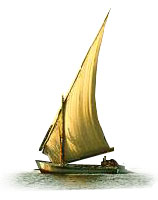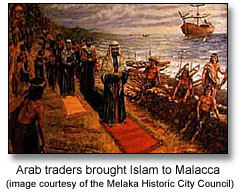
A Trader's Dream:
Tome Pries, a Portuguese apothecary who visited Malacca in the early 16th century, said that the city was "of such importance and profit that it seems to me it has no equal in the world." Part of this success came from Malice's highly organized municipal government. The port was administered by four syahbandars, or harbor master, each of whom was assigned to a group of nations. Captains of arriving ships would report to their particular syahbandar, whose staff would then provide the him with elephants to carry his cargo to a nearby warehouse specifically allotted to him. Traders paid customs based on the value of the merchandise and their port of origin, and gifts were presented to the ruler, the bendahara (chief minister), the temenggung (customs official), and the syahbandar. Large ships paid a 6 percent flat-rate based on the value of their cargo.
Once duties were paid, Malay merchants would buy the goods, then sell them in the marketplace or ship them off to other nearby ports. The entire process was fair and fast, and traders were almost always guaranteed to be finished in time to catch the monsoon winds home.
1400 AD - 1511 AD
 Until the 15th century, the
Hindu kingdoms of peninsular Malaysia were largely
overshadowed by neighboring kingdoms in Cambodia and
Indonesia. The strongest of these kingdoms was called Srivijaya,
and the records of Chinese, Indian, and Arab traders laud
it as the best trading port in the region. It was the
first great maritime kingdom in the Malay archipelago,
and other ports quickly emulated its success. At some
time around the 13th century, as other entrepots emerged,
Srivijaya's influence declined. The lack of a strong
central power, coupled with the ever-present nuisance of
pirates, amplified the need for secure, well-equipped
port in the region. Fate would make this port the city of
Malacca.
Until the 15th century, the
Hindu kingdoms of peninsular Malaysia were largely
overshadowed by neighboring kingdoms in Cambodia and
Indonesia. The strongest of these kingdoms was called Srivijaya,
and the records of Chinese, Indian, and Arab traders laud
it as the best trading port in the region. It was the
first great maritime kingdom in the Malay archipelago,
and other ports quickly emulated its success. At some
time around the 13th century, as other entrepots emerged,
Srivijaya's influence declined. The lack of a strong
central power, coupled with the ever-present nuisance of
pirates, amplified the need for secure, well-equipped
port in the region. Fate would make this port the city of
Malacca.
According to the Malay Annals, Malacca was founded in
1400 by a fleeing Palembang prince named Parameswara.
Its rise from a village of royal refugees to a wealthy
kingdom was swift. Perfectly located for trade, within 50
years it was the most influential port in Southeast Asia.
At any one time, ships from a dozen kingdoms great and
small could be seen in the harbor. With these traders
came Islam, and Malacca's rulers now referred to
themselves as "sultans." The sultans were the
heads of a highly organized municipal government, whose
main purpose was to facilitate trade. Every incoming ship
was met by a multilingual harbor capitan, whose staff
would see to all the vessel's needs. There were also
gaurded storehouses where goods from the interior and
abroad could  be
stored until traders arrived. Most importantly, Malacca was able
to control what had always been the bane of trade in the
Straits area - pirates. By building alliances with
outlying tribes and ports, Malacca established a kind of
regional "navy" that policed the local waters
and escorted friendly vessels.
be
stored until traders arrived. Most importantly, Malacca was able
to control what had always been the bane of trade in the
Straits area - pirates. By building alliances with
outlying tribes and ports, Malacca established a kind of
regional "navy" that policed the local waters
and escorted friendly vessels.
With the success and power it enjoyed, Malacca came to control the entire west coast of the Malay peninsula, the kingdom of Pahang, and much of Sumatra. At the height of its power, however, fate would ruin the city as quickly as it built it up. In 1511, the Portugeuse arrived, beginning a colonial legacy that would last well into the 20th century.
Ancient Malaysia | Hindu Kingdoms | The Golden Age of Malacca | Colonial Malaysia | Independence and Onward
Home | Places | People | History | Nature | Activities
| Fun | Essentials | Calendar
The Original
Official Homepage of the This page,
and all contents of this Web site are Copyright (c)
1996-2002 by interKnowledge
Corp.. |